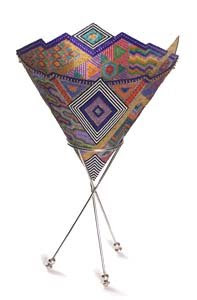Bead Weaving: Sculptural Art and Beyond
4 Minute Read
For bead newbies and pros alike, this article is sure to provide you with some interesting information. Here, you will find details on bead weaver Madelyn Ricks, the history of glass beads, and various bead weaving techniques.
Madelyn Ricks: Bead Weaving Extraordinaire
For those of you who have been attracted by Bead Weaving - Madelyn Ricks is a household word. For a metalhead like me - she was a revelation!
Madelyn Ricks, a former potter, did not discover her love of beads right away. She'd always had an artisitic inclination, forming her creativity through childhood paintings and later, with Halloween costumes for her daughter.
A full-time studio artist since the 1980s, Madelyn realized her love laid in the process, especially of small scale works. Hence, bead weaving came into the picture. Ever since, Madelyn has only grown this love affair with art, creating amazing bead works such as her famous line of Kimonos.
She works exclusively in peyote stitch; she uses Japanese Delica seed beads for her very popular Kimono series, whimsical sculptures, and jewelry. To see more of her works, check out her exhibition with Mostly Glass right here.
Weaving Glass Beads
Some of her Wall Objects are Neckpieces. For those, in addition to Peyote, she uses a single-needle right angle weave, and prefers the Czech seed beads because their roundness gives the pieces a different look and shape.
A Brief History of Bead Weaving
The Making of Glass Beads
Bead Weaving Techniques
For More On Beads…
- Madelyn Ricks's Website - https://mostlyglass.com/
- "Bead Jewelry" - https://www.ganoksin.com/article/bead-jewelry/
- "Beading Tool Tips" - https://www.ganoksin.com/article/beading-tool-tips/
- "Beads in Contemporary American Art" - https://www.ganoksin.com/article/beads-contemporary-american-art/
- "Enameled Spiral Beads" - https://www.ganoksin.com/article/enameled-spiral-beads/
This article originally appeared on Ganoksin User Blogs in 2008. It has been lightly edited to reflect updates.
You assume all responsibility and risk for the use of the safety resources available on or through this web page. The International Gem Society LLC does not assume any liability for the materials, information and opinions provided on, or available through, this web page. No advice or information provided by this website shall create any warranty. Reliance on such advice, information or the content of this web page is solely at your own risk, including without limitation any safety guidelines, resources or precautions, or any other information related to safety that may be available on or through this web page. The International Gem Society LLC disclaims any liability for injury, death or damages resulting from the use thereof.
The All-In-One Jewelry Making Solution At Your Fingertips
When you join the Ganoksin community, you get the tools you need to take your work to the next level.
Trusted Jewelry Making Information & Techniques
Sign up to receive the latest articles, techniques, and inspirations with our free newsletter.
